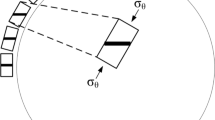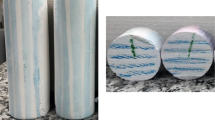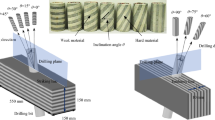Abstract
In this paper, uniaxial compression tests on layered rock specimens are numerically modelled using the discrete element method to investigate the effect of a soft interlayer on the strength and deformation of rock specimens. For these simulations, the thickness and dip angle of the soft interlayer were varied. Thirty-five numerical models for different cases were established after calibrating the micro-mechanical parameters of the hard and soft rock materials. The computational results were analysed in terms of three aspects: the stress–strain curves, micro-crack propagation patterns, and particle velocity fields. The stress–strain curves indicate that increasing the thickness and dip angle of the soft interlayer causes the peak stress and ultimate strain to drop by up to 42% and 34%, respectively. The thickness of the soft interlayer has a greater influence than that of the soft interlayer dip angle on the uniaxial mechanical behaviour of the rock specimen. Additionally, crack propagation patterns and particle motion in the layered rock models indicate that the cracks develop preferentially along the soft interlayer and that the notable failure features of the layered rock models are stepped failure modes that occur at greater dip angles.











Similar content being viewed by others
References
He MC (2002) Soft rock engineering mechanics. Science Press, Beijing
Salamon MDG (1968) Elastic moduli of a stratified rock mass. Int J Rock Mech Min Sci Geomech Abstr 5:519–527
Taliercio A, Landriani GS (1988) A failure condition for layered rock. Int J Rock Mech Min Sci Geomech Abstr 25:299–305
Amadei B, Pan E (1992) Gravitational stresses in anisotropic rock masses with inclined strata. Int J Rock Mech Min Sci Geomech Abstr 3:225–236
Yong MT, Ming CK (2001) A failure criterion for transversely isotropic rocks. Int J Rock Mech Min Sci 38:399–412
Yong MT, Ming CK, Juang CH (2006) An experimental investigation of the failure mechanism of simulated transversely isotropic rocks. Int J Rock Mech Min Sci 43:1163–1181
Huang S, Ding X, Wu A, Lu B, Zhang Y (2012) Study of multi-joint constitutive model of layered rock mass and experimental verification. Chin J Rock Mech Eng 31(8):1627–1635
Han B, Wang Z, Ding X, Ping X (2007) Numerical simulation for rheologic characteristics of interbedded strata of soft and hard rock. J Yangtze River Sci Res Inst 24(2):25–29
Xiong L, Yang L (2011) Numerical analysis for viscoelasto-plastic rheological property of interlayered rock mass. Chin J Rock Mech Eng 30(Sup1):2803–2809
Cleary PW, Pereira GG, Lemiale V, Piane CD, Clennell MB (2016) Multiscale model for predicting shear zone structure and permeability in deforming rock. Comput Part Mech 3:179–199
Lanari M, Fakhimi A (2015) Numerical study of contributions of shock wave and gas penetration toward induced rock damage during blasting. Comput Part Mech 2:197–208
Oñate E, Zárate F, Miquel J et al (2015) A local constitutive model for the discrete element method. Application to geomaterials and concrete. Comput Part Mech 2:139–160
Rojek J (2014) Discrete element thermomechanical modelling of rock cutting with valuation of tool wear. Comput Part Mech 1:71–84
Donzé FV, Bouchez J, Magnier SA (1997) Modeling fractures in rock blasting. Int J Rock Mech Min Sci 34:1153–1163
Scholtès L, Donzé FV (2013) A DEM model for soft and hard rocks: role of grain interlocking on strength. J Mech Phys Solids 61:352–369
Duriez J, Darve F, Donzé FV (2013) Incrementally non-linear plasticity applied to rock joint modelling. Int J Numer Anal Meth Geomech 37:453–477
Duriez J, Scholtès L, Donzé FV (2016) Micromechanics of wing crack propagation for different flaw properties. Eng Fract Mech 153:378–398
Jiang Y, Xian X, Xu J, Xiong D (2004) A research on sandstone uniaxial and triaxial compression tests. China Min Mag 13:66–69
Chen C (2017) Experimental study on time-dependency of rock under uniaxial compressive load. Dissertation, Chongqing University
Jing L, Hudson JA (2002) Numerical methods in rock mechanics. Int J Rock Mech Min Sci 39:409–427
Jing L (2003) A review of techniques, advances and outstanding issues in numerical modelling for rock mechanics and rock engineering. Int J Rock Mech Min 40:283–353
Karampinos E, Hadjigeorgiou J, Hazzard J, Turcotte P (2015) Discrete element modelling of the buckling phenomenon in deep hard rock mines. Int J Rock Mech Min Sci 80:346–356
Bai QS, Tu SH, Zhang C (2016) DEM investigation of the fracture mechanism of rock disc containing hole(s) and its influence on tensile strength. Theor Appl Fract Mech 86:197–216
Cundall P (1971) A computer model for simulating progressive large-scale movement in block rock systems. In: Proceedings of international symposium on fracture, ISRM, Nancy, 11–18
Cundall PA, Strack ODL (1979) A discrete numerical model for granular assemblies. Geothechnique 29:47–65
Donzé FV, Richefeu V, Magnier SA (2008) Advances in discrete element method applied to soil, rock and concrete mechanics. Electron J Geotech Eng 8:1–44
Tran VT, Donzé FV, Marin P (2011) A discrete element model of concrete under high triaxial loading. Cem Concr Compos 33:936–948
Šmilauer V et al (2015) Yade Documentation, 2nd edn. The Yade Project. doi:10.5281/zenodo.34073. http://yade-dem.org/doc/
Yao J (2015) Study on sandstone rheological tests and their factors analysis. Dissertation, Chengdu University of Technology
Acknowledgements
The authors acknowledge the financial support from the National Natural Science Foundation of China through the Project No. 51479137. The authors also acknowledge the reviewer’s work contributing to this article.
Author information
Authors and Affiliations
Corresponding author
Ethics declarations
Conflict of interest
On behalf of all authors, the corresponding author states that there is no conflict of interest.
Additional information
Publisher's Note
Springer Nature remains neutral with regard to jurisdictional claims in published maps and institutional affiliations.
Rights and permissions
About this article
Cite this article
Xie, L., Jin, P., Su, TC. et al. Numerical simulation of uniaxial compression tests on layered rock specimens using the discrete element method. Comp. Part. Mech. 7, 753–762 (2020). https://doi.org/10.1007/s40571-019-00307-3
Received:
Revised:
Accepted:
Published:
Issue Date:
DOI: https://doi.org/10.1007/s40571-019-00307-3




